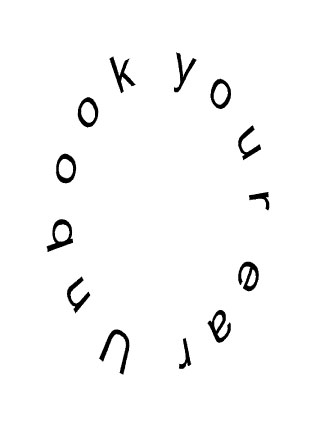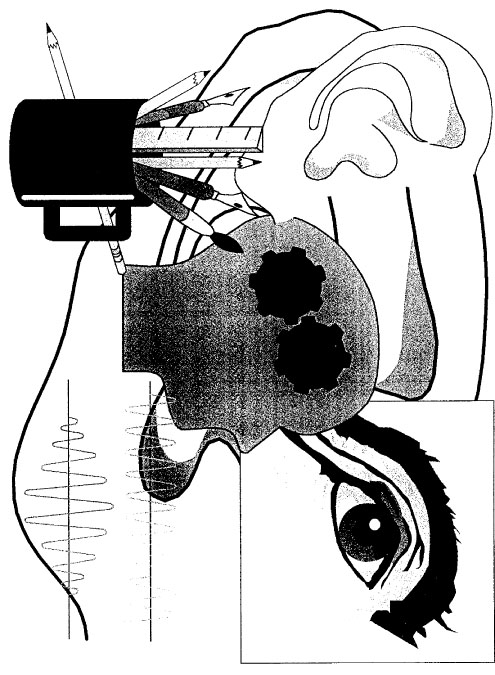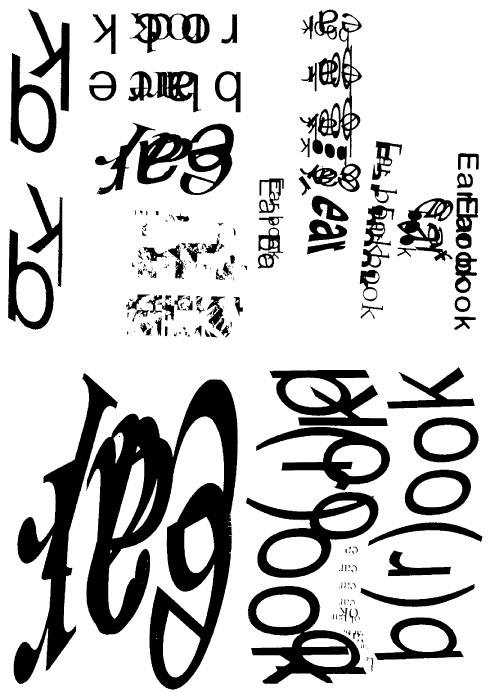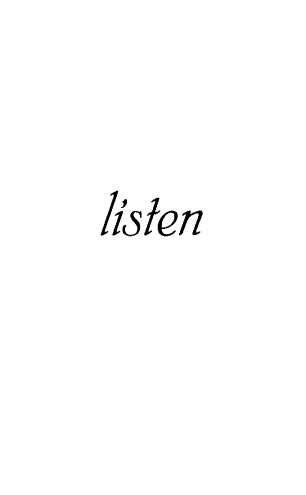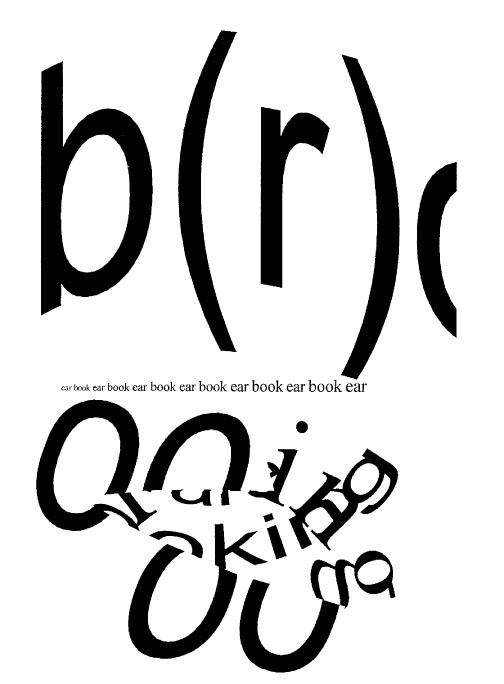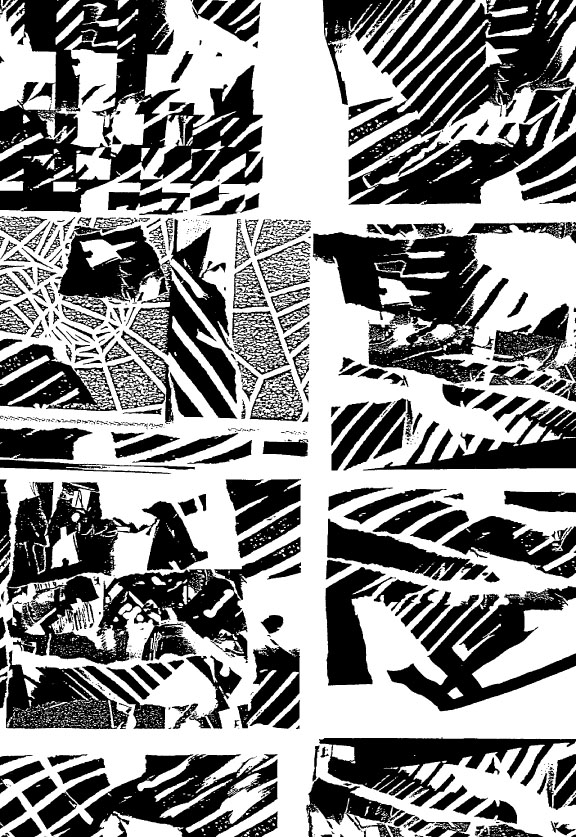
|
|

"Bob Cobbing and Lawrence Upton have been collaborating for some years on a
project which has been given the name Domestic Ambient Noise/Moise (also
known as Dan/m or DAN). This project consists of one poet presenting the
other with a theme from which the second makes six variations. This is
published as a booklet. The first poet will then choose a theme from this
booklet from which to make another six variations - a second booklet - and
so on. The project will be completed in 2000 with the 300th booklet - a
total of more than 1800 pages of visual (visually emphatic) poetry.

All thumbnails will link to larger, high quality scans of the illustrated work. |
Domestic
Ambient Noise/Moise 'It's
rather hard to understand! (You see she didn't like to confess even
to herself, that she couldn't make it out at all.) 'Somehow it seems
to fill my head with ideas - only I don't exactly know what they are!
However, somebody killed something : that's clear, at any rate…'
Domestic Ambient Noise/Moise, proliferates possible extensions to the polysemous transhistories of material poetries. d a n / m interrogates and explodes, what is familiarly understood as the 'pattern poem', somatic mark-making.1 It achieves this, through exploring the surface terrains of the page, and beginning to turn the para and peri-textual ecological imperatives of the book as a marketing tool of the Enlightenment, into an agency not of the preservations and retrievals of factual knowledge but of thickening doubts appropriate to certainties unravelling. In doing so d a n / m disinters avatars of scriptural knowledge, to articulate fissures within artifices of pages. Artifice is based upon recognition of pattern and play with that recognition of pattern; resulting, for Baudrillard, in simulation, giving way to the illusions of meaning. Our way of keeping the world 'at bay', accordingly is to:
'give it force of reality, make it exist and signify at all costs, take from it its secret, arbitrary, accidental character, rid it of appearances and extract its meaning . . .'
And we accomplish this objectification, suggests Baudrillard, through the employment of a 'machinery of reason which is itself now coming apart'.2
However, to isolate any one feature of d a n / m and damn it on that basis is absurd, its argument is far more wide-ranging and complex than that; d a n / m doesn't merely represent fracture and rupture but the throes of facture and rapture. There might, adapting McCaffery and Rasula's phrase, be times when it presents meaning as going on holiday whilst retaining its old address,4 but it doesn't lose sight of an everyday poesis (the making or the production of things) in dynamic interchange with everyday praxis (affective, rehabilitative actions in the public sphere). The issue of the 'public sphere' here and of whether any resultant 'going beyond' or 'making a leap' can lead to an arrival that offers understandings useful to many others is still highly debatable. The project isn't closed.
The patterns of insistent, processual materiality, generated between these 'texts', enable us to begin to make maps of consensual 'slippage'; of those moments in-between communication most often edited from analysis, if not from consiousness. Insistences of pattern read as states of editorial attention. Akin to those marks of Cy Twombly, which Barthes refers to as 'so many little satoris . . . writing . . . literally in excess'.5
Cobbing and Upton, present mimesis of excess. Forms of information storage, inscribing value to information that other writers might rightly or wrongly discard, thereby challenging conventions of usage and retrieval in the pool of meaning making. d a n / m is beligerently inclusive, to the point of overload. Features are made of distending through enlargement and reduction, of 'poor quality' copying, of faulty computer print outs, of high quality reproductions of what might conventionally considered to be unreadable and so on. Through knowledge of such possibilities, they become integrated into the 'performance' of the writing, at every stage of production and reproduction. d a n / m challenges its readers to engage with a ribald body, rather than a fashionable curve, of process.
A prescient scene in Hard Times prefigures d a n / m, through which, in the mid 1850s, Charles Dickens shows us Mrs. Sparsit indulging in an early instance of what hacker slang terms 'trashing'.6 In the act of trying to reconstruct the day's events at the Bank, and thereby to work out what the men who work there 'know', by scrying 'blots of ink, worn-out pens, fragments of wafers, and scraps of paper torn so small that nothing interesting could ever be deciphered on them',7 she confronts the world of rational, male-dominated, bureaucratic business, as an incomprehensible void. In her attempt to 'master' this universe, to adopt its legitimating language, she is depicted as herself the mistress of nothing. Her naming reveals its derivation, she is retained beyond its comprehension. Bewilderment opens around her like a chasm, a skid into maelstrom, 'noise' overwhelms her, and signals those crises of 'knowledge', in relation to entropic selections from an overload of available data, that would attempt resolve in meta-narrational projections of Modernism and in the wakes of that
*
In 'A Tour of the Monuments of Passaic, New Jersey' (1967), entropy is defined by Robert Smithson by means of what he himself terms a jejeune experimental proof:
'Picture in your mind's eye the sand box divided in half with black sand on one side and white sand on the other. We take a child and have him run hundreds of times clockwise in the box until the sand gets mixed and begins to turn grey; after that we have him run anti-clockwise, but the result will not be a restoration of the original division but a greater degree of greyness and an increase of entropy.'8
Translate Smithson's story into processes of both writing and reading and that sand box becomes a sheet or sheaf of papers. The black sand is the 'writing' or the mark makings, the white sand conventionally, although not necessarily in d a n / m those negative spaces between them. The boy running becomes an eye scanning, a silent tongue sounding, and all necessary engagements of the human body-mind that constitute ontological production of meanings. The 'greyness' which results is not a uniform grey, but composed of degrees, particularities, differentials of event. Entropy as defined here is more than a process of Lacanian loss, that might, understandably, be applied to a process of reproduction. Such loss implies an originary moment and d a n / m does not claim one. Accretions of 'greyness' throughout d a n / m can be read as metaphors of informational entropy. The discourse between presences and absences which results, might be read through Deleuze and Guattari's formulation of the 'desiring-machine';9 as tensions 'between sub - and superpersonal tendencies that intersect in the person as empty category'.10
Schwitters 'merz' featured diverse 'trophies', of quotidien ephemera collected in the basket on the front of his bike; bits of litter, torn posters, tram tickets, packaging imagery, used postage stamps, cigarette wrappers, and more: all contributed to their forging.
Cobbing says: 'Whether one finds things on the bit of grass on the other side of the road or whether one finds things in the back of one's mind, one still is finding things and you've always got to work on them, you've always got to transform them in some way. That's what I really think art's all about, finding and transforming.'11
Mrs. Sparsit caught like a rabbit in the oncoming headlights, stopped short of that transforming, in Dickens' depiction, and fulfilled her sense of herself as disenfranchised victim.
Reading : ear book from d a n / m (November 1996)
A stack of textual arcs, an 'aural' economy, decorates the cover.12 On the 'theme' page, 'ear book' has been handwritten in two different hands with different pens. These signature hands implicate a sound difference. We tongue them with our eyes. The rest of the page is 'blank' or silent - but which is the silence and which is the noise? Variation 1 has a simple outlined oval of text, reading 'Unbook your ear', it's a loop. What is the orientation of this page, are we expected to turn it as we read?. Variation 2 combines instruction book or clip art style line images for 'writing' and 'drawing', for production and deciphering of sound and sight linked through human 'cognition'. Variation 3 juxtaposes six constellations of computer set text, using the words and letters from the words 'ear' and 'book' in non-semantic, horizontal and vertical orientations. Are 'book' and 'ear' then interchangeable? Letters among letters threaten to form intra-words. Variation 4 has the word 'listen' verticalised as portrait. Variation 5, 6 and 7 are blank pages - again, are they silence or 'noise'? Variation 9 presents dense overlayings of the words ear book, portray a head - its features opaque and resonant with 'noise'. Variation 10 reads 'listen' , repeated, landscape - an echo, forming a horizon, with the head of the I, the period extended into a quote. Person, supine or sleeping, within whom point of closure has become representation as reference within lineage? (Figures 1-6)
Figures 1-2. Variations 1, 2 from ear book d a n / m (November, 1996)
Figures 3-4. Variations 3, 8 from ear book d a n / m (November, 1996) Figures 5-6. Variations from ear book d a n / m (November, 1996)
The crescendoing ear book ear book that bisects its final variation suggests a slang 'look 'ere', as an aural ellision and syncretic joke. So, what are we to make of the shift from three blank pages to dense typographical 'image'? Do readers linger on the blank pages, or simply flip through them as unworthy of attention, as abberation? Does a blank page not have duration? Does a blank page not present an interface into which the everyday flow of each reader interpretation pours? Are the gaps between the notes not important to the appreciation of the notes? Is silence without codes? This book, is structured, perhaps, as a sonic performance. One looks at it.
*
In an anxiety, born of that wish to be able to separate the 'authentic' utterance, from the tarnish of 'authorial' immanence, writing is desired to be only that which resides on the page. Texts are, in the privileging eyes of such readers, dubiously compounded and so consequent readings hindered, by the noisy significances of physical gestures, facial expressions, intonational 'tricks', seductive clothes or not, peer response and so forth. A hankered-after 'purity' is corrupted, made dirty, by the baggage of physical exchange; through everyday modalities, persistently inscribed onto, and mediated by each human body. Can such details of the mechanics of social dispersal not also be read? Do they not propose to tell us something of potential interest, even use, about human society as a conversational swarm?
*
'Literacy', became promoted as a 'higher', more objective or autonomous, form of knowledge, in many cultures, exactly because it is not as immediately socially dispersive, or so obviously ephemeral as 'orality'. It took root in the West, according to Foucault's account, through taxonomic ambition, exemplified by the encyclopaedic projects around the turn of the seventeeth century. He writes, that, 'such an interweaving of language and things, in a space common to both, presupposes an absolute privilege on the part of writing'.13 'Literacy', grafts onto its construct, an association with the higher or more sophisticated echelons of a given society, with a priesthood, or an intelligentsia, or an academe, or a policy elite. 'Literacy', can be regulated through occupations of power, through the agencies of convention. Meanings, and their proliferative tendencies, can be controlled, and owned. As Foucault puts it, 'the author is the principle of thrift in the proliferation of meaning'14
'Orality', has by contrast been more associated, by literatii, with redistribution of information already acquired; with repetiton rather than with origination.15 A hierachy, based on literate values, considers downgraded those sites of oral proliferation in the everyday, and the 'billingsgates' common to them, Malinowski's phatic communion. Orality thereby becomes tarnished itself, associated with transitory topicality, with trivia, tittle-tattle and yiminy piminy. Foucault goes further, showing the spoken word at the turn of the seventeenth century becoming aligned with the passive intellect as 'the female part of language'.16 Writing, as paginated text, was ensconced, as the active male intellect, and the harbor of truth, as phallogocentric matters of fact.
'. . . in vivo and in vitro. Biochemical mimesis mutates the modernist anxiety about authenticity.'17
Writing and publishing might therefore be considered as related to eugenics and the issues of anxiety thereby raised; patriarchal drives, production of offspring, reproduction of preferential 'self'. Authors, through the agency of their publishers, like contestants at a beauty contest, setting out their bodies of work, (or 'Arnies') in order to be successful, as the chosen tokens against threats to the social fabric posed by 'proliferation of meanings'.
Among increasingly hybrid texts, intertextual boundaries, between niche market readerships and producer-consumers of mass market writings, are sites of contestation - through blur, slippage, fracture, erosion, granulation and immersion. Out at the words market, a sufficiently wide range of aspirational tastes is being catered for, such is the myth of choice, to result in the seeming absorbtion of 'all', by the artifices of a capitalist society obsessed with controlled diversity as an engine of its survival.
The subject of this paper, Domestic Ambient Noise / Moise, is a collaborative writing which roadtests that stamina for absorption within the society that has asked for it. Typically, it interrogates conventional boundaries of concensual meaning formation and in the process of so doing it establishes a construction site for potentially unassimilable proliferations of meaning. 'Authorship', far from providing a buffer between readers and 'the great danger with which fiction threatens our world', ('Are Your Children Safe In the Sea' asked Cobbing thirty years ago) becomes an active agent for engagements of interest with the formlessness of indefinite community. d a n / m's progenitors will be both applauded and cold-shouldered for their tenacity in proposing that interest.
*
Whilst references, representations and meanings will continue to proliferate as d a n / m is processed, for some readers the terms of engagement are already barren, too immersed in acts of negation. Too often for them, d a n / m offers only invocations of the denial of consensual meaning, mockery of the need for meaning as a symptom of socio-deficiency, or active erasure of existing common sense. These are, for such readers, 'writings' ready-redolent of neo-dadaism; yet more conceptually packaged artists' shit. d a n / m can be misunderstood then, as no more than a re-presentation of Mrs. Sparsit's 'impossible void'. Its depictions of textuality so dissipated as to be unreadable, within terms of readability measured against dominant linguistic practices. Letter forms have exploded their delineations to become blotches and globules. Inkish stains muck out the page, turning conventional interdependencies between text and background upside down and inside out. Ink, medium of positive articulation, literally blots conventionally negative spaces between letters and words, rendering the page opaque with necro-lingo-goo. Too many boundaries are being blurred at one time.
*
Twentieth century developments in accessible technologies for 'indirect testimony', the various reproductions made possible through systems of 'recording', have certainly skewed boundaries between 'ephemerality' and 'longevity'. It is now possible, for example, to hear Kurt Schwitters' own performance of the whole of his Ur-Sonata, discreet speech components treated as units from which to compose relatively precise structures for vocal performance, as well as to 'read' printed versions of this text. Although, as Bernstein says, new critical issues emerge as a result, regarding:
'the status of discrepancies among performed and published versions of poems, and moreover, between interpretations based on the text versus interpretations based on the performance?'18
Despite anxieties raised, by the reinvigorated spectre of 'authentic utterance', and what price Dolly the cloned sheep in this cultural festival of copies, those most obvious rifts, between conventions of 'performance' and 'page', connected to relative 'perishabilities', have partially healed.
*
Domestic Ambient Noise / Moise deliberately confounds the aural and visual to boot. For Cobbing, using the Japanese word 'kaku', writing and drawing are essentially the same.19 Counter to the eye 'being destined to see and only to see, the ear to hear and only to hear',20 Cobbing's and Upton's insistence is on creating charged transitions between aural and visual registers; in the cases of smudges and puddles and gouges and smears (inclusive of alphabetic forms, runic systems, oggamic writings, logosyllabic, calligraphic and pictographic facture). Intent is on interaction and concomittant transition, as much as on discreetness, between juxtaposed material elements; frequently foregrounded in twentieth century art works and forming part of a wider registration of those moment(s) hingeing between continuity and discontintuity.
'The minimum real unit is not the word, the idea, the concept or the signifier, but the assemblage. It is always an assemblage which produces utterances . . . the utterance is the product of an assemblage - which is always collective, which brings into play within us and outside us populations, multiplicities, territories, becomings, affects, events.'21
Acts of assemblage then reveal the workings of the manufactures of concensus. They can further such manufactures, and they can challenge the political ideologies that underpin or undermine the desires that drive such necessities. d a n / m is partially becoming a contemporary sourcebook of material poetic assemblages, a not so m uch exemplary as salutary compendium of period connectionism, a sampler hooked up to a hard drive as it crashes, grabbing snapshots from total recall.
*
Renewing anxieties, via the agency of 'indirect testimony', concerning the authority of utterance, led Derrida to assert that the West had become trapped by the voice. 'Logocentrism: the metaphysics of phonetic writing',22 as transcription of the living voice, which Derrida seeks to unshackle from phonocentrism, is, for him, a distinctly ethnocentric problem; a Western logocentrism, locked into tracing reality through phonetic mimesis. Yet, although from a position that must be understood as one embedded within hermeneutics, Zhang Longxi asks:
'if logocentrism is found in the East as well as in the West, in nonphonetic as well as in phonetic writing, how is it possible for us to break away from, or through, its enclosure?'23
Zhang suggests that those writings, such as Egyptian hieroglyphs and Chinese characters referred to by both Foucault and Derrida as nonphonetic and direct representations of 'things', are, in fact:
'sweeping generalisations about East - West cultural differences . . . very much the result of misconceptions or of a wilful projection of the desire to differentiate the Western Self from a non-Western Other.'24
Let's try another tack.
'From Plato to Leibniz, we have been able to observe a few modifications but no real displacement in the field of debate, whose active center has remained mimema phone, imitation of meaning by vocal sounds. Now natural language does not materialize in speech only but in writing, too, and beside a phonic mimesis (or below it, or above it, depending; . . .) can be dreamed - has been dreamed - a graphic mimesis: imitation by the concrete forms of writing. Imitation of what?'25
The basic principles of an alphabetic writing, 'to represent a single sound of a spoken language by a single letter',26 supplemented by accumulations of visually symbolic value, are not equally directly applicable to other writing systems. In addition, whilst the principle of one sound per single letter might be sustainable in continual isolation, as soon as combinations of letters formed words and words passed from mouth to mouth and community to community through time, such neat distinctions blurred into complex knots of influential stress, that have resulted in fold upon fold of buckled, rather than teleological, developments.
Genette is cunning therefore, in not putting his emphasis onto imitation of physical objects, but crucially, into imitation of meaning. For meaning implies human interaction and contextual specificity. Meaning is 'motivated' within particular historical and cultural frames. Far from being arbitrary, meanings are produced by specific details, of varying ephemerality.
Consensual realities in respect of meaning need to be mapped onto that 'unanchored slippage from signifier to signifier, pure unmotivated metonymy in a one-dimensional world without metaphor', which Massoumi emphasises is 'produced by determinable social functionings within a real network of power relations'.27
Situationism, developing from Lettrisme, took the concern for creativity and meaning in the context of the struggles of everyday life seriously. Its programme agitating towards taking control of the production of meaning, addressed through the deconstruction of dominant, or territorialised, linguistic inter-relationships, was seen as part and parcel of the workers' demands to take control of the means of production. Perhaps a deconstruction of the means of the social construction and state representation of production is part and parcel of retaking control of what meaning can be. Meaning need not be the instrument of a coercive state. It might or it might not be appropriate to talk of meaning as a meeting between intention and interpretation, as Fiona Templeton puts it in the afterword to You : The City; for perhaps such a meeting is perceptable to neither the intender nor the interpretor at that time.
*
In 1966 Cobbing used the stencil of the announcement for the 'Destruction in Art Symposium',28 gradually mutilating and destroying it, making 500 prints on a mimeo machine of the whole process of disintegration.29 What we must ask is, whether the writing is in the materiality of all of the prints forming parts of the process, or whether it is in any chosen print plucked from the series or whether it is merely in the conceptual conceit brought to the framing of the idea, without the idea itself adding anything significant through its implementation? In all those cases, the writing is a 'skin of the event', tracing boundaries between the discreet event and its more mediated worlds; registers of absence through material presence.
*
One way, through which living language becomes petrified into a prescriptive structure, is described by Massoumi, echoing Bourdieu's 'linguistic communism', as the combination of 'the Saussurian concept of 'langue' and the Chomskyan concept of 'competence', that he holds responsible as 'bedfellows to linguistic terrorism in the cause of unity'.30 A properly homogenous language or speech community is a dystopian dream. Both 'langue' and 'competence' oppose and absorb in order to normalise variations that disrupt continuities of meaning. Such thresholds of social polyglossia, as dialects, ideolects, argots and jargons, which contribute strongly deterritorialising components to the pulp fabric of the 'page' of the colloquial. There is no absolute world, as there is no absolute truth, even at any given point, to form the subject of mimesis.
Of course meaning is not limited to the conduits of spoken and written language, as they are commonly understood. Meaning is also constructed pictorially, spatially, through gesture and posture, through 'habitus'and through manipulation of sounds not based in speech. Meaning is certainly thereby not limited to representation as 'message received, over and out' however much that might be wished. Hence misunderstanding, deliberately fostered throughout d a n / m, can be engineered and mobilised through assemblages of displacement, misspellings, mishearings, vaudevillean rhetorical devices, mime and disguise to both unsettle and prvoke reaffirmations of our commitments to meaning making. d a n / m is a humane device.
*
The problem, as posed by Plato, is that poets copy 'indiscriminately'. In other words, they reflect too clearly the whole, rather than editing out and representing chosen highlights to make a clear point. Readers in agreement, would rather not have the blotches and scars of language which d a n / m portrays, presented in such graphic forms. They'd prefer them to be more mediated, even ameliorated. The 'truth' of the full body of language is unsavoury to them. Better, a more sanitising, preferably beauteous, mirror were held up to their world.
Plato's second objection,31 a direct contradiction of the first, is that poets do not copy 'truthfully', but are accused instead of distorting and refracting 'truth' in their process. Poets destabilise the links between signifier and signified.
*
The Structuralist anthropologist and paleontologist Andre Leroi-Gourhan writes of the emergence of 'two functional pairs (hand/tools - face/language)' that became agents for the modelling of thought; into instruments of material action as tools, and into sound symbols as language. 30,000 years B.C., 'graphism did not begin with naive representations of reality but with abstraction', which engaged magical-religious concerns, linking the origins of figurative art directly to language. Early graphism then was a form of writing, expressing rhythms rather than forms and constituting a 'symbolic transpositon, not copying of reality':
'in other words, the distance that lies between a drawing in which a group agrees to recognize a bison and the bison itself is the same as the distance between a word and a tool. In both signs and words, abstraction reflects a gradual adaptation of the motor system of expression to more and more subtly differentiated promptings of the brain. The earliest known paintings do not represent a hunt, a dying animal, or a touching family scene, they are graphic building blocks without any descriptive binder, the support medium of an irretrievably lost oral context.'32
There is an engagement with 'lost oral context', that Foucault calls 'primal discourse',33 throughout d a n / m. As if it seeks to present archaelogical finds from the discarded fluff of our hopelessly literate states of consciousness, as site reports, in order to conduct a socially empowering map of the collective's unconscious past.
d a n / m suggests mimesis of ur-language, that formlessness that interrogates the boundaries of perceptible form; that supposed loss of definition which has, until more recently, got such bad press. d a n / m raises the spectre of chaos, not only the psychic darkness, forged and driven to ground by the trauma of industrialisation, but its textual 'digs' also present a powerful source for generating reconstruction from the post-industrial wake.
*
During 1996, hypertext and cybertext practitioners contributing to discussions on the electronic 'list' 'ht-lit', were debating 'what's in a link?' The shift from word to word, formation of linkage, that assemblage defined by Deleuze as the producer of utterance, can be read as a shift from moment of closure to moment of closure . Closure is at work in any given juxtaposition of words, and by extension operative between books in a serial publication, whether it be Gaiman & McKean's Signal To Noise34 or Cobbing & Upton's Domestic Ambient Noise / Moise.
Scott McCloud discusses closure, in the context of 'links' between frames in comic books; 'the phenomenon of observing the parts but perceiving the whole'.35 'In our daily lives', writes McCloud, ' we often commit closure, mentally completing that which is incomplete based on past experience'. He delineates ways in which closure operates in the space between comicbook frames; suggesting that closure is a grammar, performing within the vocabularies of visual iconography. Closure, is working away in the 'gutters' as engagement moves from frame to frame. Figure 7. 'Love' comic No. 3 Figure 8. From d a n / m (1996-7) (no publisher identified) (August 1995)
This is a'network' of books, a book-based poetics of domestic space, written and drawn around the house, printed in the basement, collated and mailed out from the kitchen table; occupying, demotic and local. It presents an opening map of an arguably unfinishable territory. It positions the performance of writing, in the extremely late twentieth century, as a complex ontological navigational tool, that territorialises, deterritorialises and reterritorialises, models of linkage. Writing is links! That's how it's made, from one constructed moment, one articulated space to another; not necessarily the next, but certainly another. Linear closure, driven by desire for completion, forces an arrival of 'sense'. Lateral closure suggests a necessary acceptance of, or a resignation to, the impossibility of a single completion. It is no longer a short-range satisfaction. The horizons recede.
Taken by dictionary definition, 'Domestic Ambient Noise', suggests feeling at home with the possibility of encompassing, or of being encompassed by, interference. In Communication Studies, according to Fiske, 'noise is anything that is added to the signal between its transmission and reception that is not intended by the source'.36 'Variations' added to the 'themes' in d a n / m can be considered as interpolations between signal and reception. But variations themselves become 'themes' in this processual. Noise, is positively encouraged and d a n / m embraces its presence. Some marks in these books, have a relation to conventional lines of printed words, as much as grunts, hums, exclamatory vocal gestures and suchlike, retain a relation to a spoken sentence. Textual distortions, deliberate misunderstandings, erasures, blottings out; all can be read as noise between the means for sustaining and generating processes of versioning, the events and the sites of the events of transforming.
Reading : als from d a n / m (November 1996)
Even to type the title, floating clear from 'false' on the book's cover, is a misnomer. 'als' is extracted typographically from a 'theme' page, drawn from 'real estate and pirate arts', on which:
'True
False'
are located, with 'True' marked as 'the case', where Operand 1 has undertaken an Employee's detector test, in a sea of pixels laid over a partial grid. 'als' has been drawn from the middle of the line of letters that make up a 'legitimate word, 'false'. Variation 1, 'als' has been engulphed into a fold, or scrunch of the surface of the page. Variation 2 features a prominent 'e'. It could equally be a shorthand for gender, or the ending of either key word, meaning that the 'theme' page must be revisited in greater detail in order to ascertain that 'true' is, 'the right answer!', corroborating the Operand's response. But already this 'reading' is dependent on 'closure' that invokes conventional meaning making. Bits of the words 'True' and 'False' are placed in binary opposition to each other for two consecutive double-paged spreads. Both logos are subsequently revolved through ninety degrees to become verticalised stripes of dark matter. Words have become rendered material; their conventional meanings subordinated to their gravitas as shape. This is not writing as transcription of speaking, but the sounding of a smudge of contradictions, a polyphonic skin of noise. Paper work, the sign for the mudane office transaction, is being 'treated' into a bookwork which confounds its own accounts. Speech has become the subject of distortion and erasure. Micro-particles become 'The Stuff' and 'The Blob'. 'True' plummets towards a worm hole, opening beneath it in the pit of the page. 'False' is depicted in the process of losing its distinctiveness, a fraying net of pixels coagulating to eat into its outline, a blurring of its boundaries both in meaning and appearance. (figure 9) The texture of the page, inters and in doing so, reintegrates textual binary. Narrative drive is irresistible here. Figure 9. from als d a n / m (November, 1996) p8
|
||

